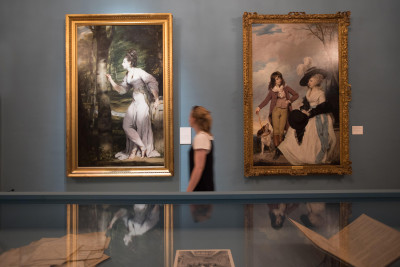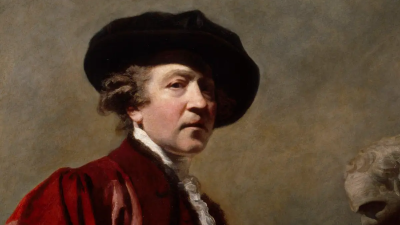
William Powell Frith RA, Claude Duval, 1864.
500 mm x 710 mm. © Photo: Royal Academy of Arts, London. Photographer: Prudence Cuming Associates Limited.
This image is not available to download. To licence this image for commercial purposes, contact our Picture Library at picturelibrary@royalacademy.org.uk
Claude Duval, 1864
William Powell Frith RA (1819 - 1909)
RA Collection: Art
Lumb Stocks was elected an Associate Engraver of the Royal Academy in 1853, the same year that he engraved Bed-Time after W.P. Frith R.A. (Frith’s painting was exhibited at the R.A. in 1852). In 1859 Stocks engraved one of Frith’s more ambitious paintings, Many Happy Returns of the Day (1856), now in the Mercer Art Gallery, Harrogate, which depicts three generations gathered to celebrate a family birthday. Stocks was therefore well-acquainted with Frith’s work by the time he undertook Claude Duval, his third engraving after the artist. He presented it to the Academy after his election as a full Royal Academician in 1871.
The subject of Claude Duval is drawn from Macauley’s History of England, about a young man from a respectable background who becomes a highwayman, and is shown here orchestrating a robbery. Stocks’ engraving of Claude Duval is almost identical in size to that of Many Happy Returns of the Day, despite the fact that the painting of Claude Duval is much larger than its counterpart. This demonstrates both Stocks’ comfort with this particular size and the way in which it follows in the footsteps of Many Happy Returns of the Day. Frith’s painting of Claude Duval (now in the Manchester City Art Gallery) was exhibited at the R.A. in 1860, the year it was painted, although it was not well-received by critics who preferred Frith’s subjects from modern life to this eighteenth-century costume piece.
Stocks’ engraving was commissioned by the Art Union of London, the first time it had engaged Stocks since his engraving of Raffaelle and the Fornarina (1842) had met with negative reviews. The print was published in 1865 but as the lettering beneath this print shows, Stocks engraved the plate in 1863 while this proof impression was ‘Published July 1st 1864 at 444 West Strand’.
Stocks probably chose this as his Diploma work because it reproduced the work of a prominent Academician. Frith himself was clearly pleased with the print, since he wrote in his autobiography that: ‘in the engraving from my own picture of Claude Duval, by my old friend Stocks, R.A.—of whom it is not too much to say that he is one of the best engravers in this or any other country—my friend has added a charm to the composition, by his exquisite rendering of every part of it, that I fail to find in the original picture’ (W.P. Frith, My Autobiography and Reminiscences, London 1888, vol.3, p.160).
Another reason for submitting Claude Duval was that, since completing it, Stocks had been working on one print which was not finished until 1872. This was an engraving of Daniel Maclise’s mural The Meeting of Wellington and Blucher at Waterloo, painted on the wall of the Royal Gallery of the House of Lords. The Art Union commissioned this print in February 1866, and he was given until April 1872 to complete the huge (122 x41cm) plate. Stocks may have hoped to complete this engraving , his undisputed masterpiece, in time to submit it as his Diploma work. In the event, however, it was not completed until 1872 (it was exhibited at the R.A. in 1874). Claude Duval, therefore, was an obvious choice. The fact that it marked his return to the affections of the Art Union, who were obviously sufficiently impressed with it to commission Wellington and Blucher shortly after, was surely another contributing factor.
Object details
500 mm x 710 mm
Start exploring the RA Collection
- Explore art works, paint-smeared palettes, scribbled letters and more...
- Artists and architects have run the RA for 250 years.
Our Collection is a record of them.



